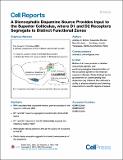A Diencephalic Dopamine Source Provides Input to the Superior Colliculus, where D1 and D2 Receptors Segregate to Distinct Functional Zones
Author(s)
Bolton, Andrew D.; Murata, Yasunobu; Kirchner, Rory; Kim, Sung-Yon; Young, Andrew; Dang, Tru; Yanagawa, Yuchio; Constantine-Paton, Martha; Bolton, Andrew D.; ... Show more Show less
DownloadBolton-2015-A Diencephalic Dopam.pdf (4.980Mb)
PUBLISHER_CC
Publisher with Creative Commons License
Creative Commons Attribution
Terms of use
Metadata
Show full item recordAbstract
Modulation of neural responses is frequently observed in the superior colliculus (SC), a retinorecipient midbrain structure that controls orienting and the localization of attention. Although behavioral contingencies that influence SC responses are well documented, the neural pathways and molecular mechanisms responsible for this modulation are not completely understood. Here, we illustrate a dopaminergic system that strongly impacts neural responses in the SC. After using RNA sequencing (RNA-seq) to detail the transcriptome of dopamine-related genes in the SC, we show that D1 receptors are enriched in the superficial visual SC, while D2 receptors segregate to the intermediate multimodal/motor SC. Retrograde injections into the SC consistently label A13, a small dopamine cell group located in the zona incerta. We surmise that A13 mimics dopaminergic effects that we observed in SC slices, which suggests that dopamine in the SC may reduce the tendency of an animal to orient or attend to salient stimuli.
Date issued
2015-10Department
Massachusetts Institute of Technology. Department of Brain and Cognitive Sciences; McGovern Institute for Brain Research at MIT; Picower Institute for Learning and MemoryJournal
Cell Reports
Publisher
Elsevier
Citation
Bolton, Andrew D., Yasunobu Murata, Rory Kirchner, Sung-Yon Kim, Andrew Young, Tru Dang, Yuchio Yanagawa, and Martha Constantine-Paton. “A Diencephalic Dopamine Source Provides Input to the Superior Colliculus, Where D1 and D2 Receptors Segregate to Distinct Functional Zones.” Cell Reports 13, no. 5 (November 2015): 1003–15.
Version: Final published version
ISSN
22111247